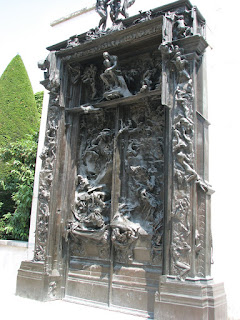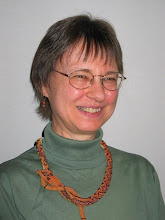Today was a day of museum-hopping, so we headed to the Musee de l'Armee (the Army Museum) located in the Hotel des Invalides complex. We purchased Paris Museum Passes, which would allow us to get into 30 museums for the price of the pass and skip to the head of the line.
Built by Louis XIV as an establisment to care for old soldiers, the structure has been a barracks, hospital, hospice, administrative center, place of worship, repository of Napolean's remains and, since the twentieth century, a miltary museum.
Here is the gold-domed structure that we photographed on the bridge on day 1. The institution continues to look after soldiers and the hospital is a modern medical facility. When you walk up to the ticket building, there is a sign posted that asks you to refrain from being noisy because it is a hopsital zone.
Like many public building in Paris, there were formal gardens on the property, this time in front of the medical section.


A close up of the flower mixture between the sculptured bushes.
Napolean's Tomb. The sarcophagus is a little over 13 feet (4 m) long, 6.5 (2 m) feet wide, and over 16 feet (5 m) tall. It is made of red quartzite. The emporer's body lies in five successive coffins made of metal and wood.
We then wandered through the World War I and World War II departments but had to skip the Arms and Armor section.
We did, of course, head to the gift shop before we left, where I found these two knitting-related post cards.
We did, of course, head to the gift shop before we left, where I found these two knitting-related post cards.
This one translates roughly (very roughly) as "Me as well, with my class, I have adopted a soldier."
After the Army Museum, we headed over the Rodin Museum, which is close by (http://www.musee-rodin.fr/). The museum is housed in the Hotel Biron, which was built at the beginning of the eighteenth century and housed sumptuous receptions for Tout Paris.
The building later served as a convent school for young girls and later as low-rent lodgings for artists, who included Isadora Duncan, Henri Matisse, Jean Cocteau, and Auguste Rodin.

The back of the museum as seen from part of the garden.

The back of the museum as seen from part of the garden.
The view from a second story window. Along with the plants, the garden was full of Rodin's bronze sculptures.....

...like this one entititled "The Gates of Hell." These doors, which we nver meant to open, were never finished for a museum that was never built. Note the smaller version of The Thinker at the middle top of the door.
As we walked over to our next museum, Don snapped this photo of one of the river boats. He liked this boat because it came with its own red car on the front of the boat.
Dodging the beggars and con artists around the Eiffel Tower, we stopped at the Musee de l"Orangerie (http://www.musee-orangerie.fr/). Once an actual building for keeping orange trees, the structure has been reimagined as a museum to house Impressionist paintings. A version of Monet's "Water Lilies", painted late in the artist's life, occupies the first floor. Downstairs are part of the personal collection of Paul Guillaume, a trend-spotting, Paris art dealer in the 1920s.
You may have noticed the distinct lack of photos, compared to the Versailles trip. Most of the museums do not let you photograph the work housed in them. Along with that restriction, I was running out of battery life and we were more focused on enjoying the artwork.
After the Orangerie, Don came up with the suggestion that we visit one last museum, the Musee du Quai Branly (http://www.quaibranly.fr/en). This is a world-class collection of "primative art" from Africa, Polynesia, Asia, and the Americas; we would have spent less time at the Orangerie if we had had any inkling of how extensive the collection was at Quai Branly. We barely scratched the surface. Unfortunately, the museum is so dark that none of our photos are good enough to post.
We did, however get a few shots of the museum facade with the living plants on it.
We did, however get a few shots of the museum facade with the living plants on it.

Here is a close up shot some of the plants.
After that it was closing time for museums, so we ate dinner at the cafe next door to our hotel. I had a green salad with ham, cheese, and walnuts, while Don decided to have a Salad Nicoise. Both of them were pretty good but the cafe was full and the service was very slow. In fact we had finished our coffee by the time the waiter came back with the dessert menu.










No comments:
Post a Comment